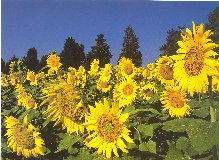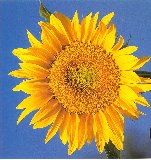Sunflower
http://www.100md.com
《e Natural Health Center》
 |
 |
 |
Flowers, Tea
Sunflower
Latin:
Helianthus annuus
Origin:
The plant Helianthus annuus L., of the family Compositae. Sunflower is native to western North America, it is the only important crop to have evolved within the present confines of the United States. Early introduced to Europe and Russia, the species has now spread to countries both tropical and temperate, cultivated primarily for the seeds which yield the world's second most important source of edible oil.
, 百拇医药
Sunflower oil is used for cooking, margarine, salad dressings, lubrication, soaps, and illumination. A semi-drying oil, it is used with linseed and other drying oils in paints and varnishes. Decorticated press-cake is used as a high protein food for livestock. Kernels eaten by humans raw, roasted and salted, or made into flour. Poultry and cage birds are fond of raw kernels. Flowers yield a yellow dye. Plants used for fodder, silage and green-manure crop. Hulls provide filler in livestock feeds and bedding.
, 百拇医药
The common sunflower is an annual herb with a rough hairy stem 1━4.5 m high, broad, coarsely toothed, rough leaves 7.5━30 cm long, and heads of flowers 7.5━15 cm wide in wild specimens and often 0.3 m or more in cultivated types. The disk flowers are brown, yellow, or purple. The oval hairy leaves are arranged in spirals.
Crop matures about 4 months from sowing; some Russian species mature in 70 days. Harvest when involucral bracts turn yellow and seeds become loose, but before shedding begins. Harvesting methods are similar to those of corn: heads are gathered, dried, and threshed. For fodder or silage, crop is harvested at the flowering stage.
, 百拇医药
Seed oil is either cold- or hot-pressed. Cold-pressed oil is usually pale yellow, with a mild taste and pleasant odor, much esteemed as a salad and cooking oil, especially for butter substitutes. Hot-pressed oil is reddish yellow and is used for technical purposes and as a burning oil. With modern methods, hot-pressed oil may be refined for edible purposes.
The sunflower plant is valuable from an economic as well as from an ornamental point of view. The seeds contain oil and are used for food. The yellow, sweet oil obtained by compression of the seeds is considered equal to olive or almond oil for table use. Sunflower oil cake is used for stock and poultry feeding. The oil is also used in soap and paints and as a lubricant. The seeds may be eaten dried or roasted. Argentina, Russia, Ukraine, France, the United States, and China are the leading producers of sunflower seed. The leaves are used as fodder and the flowers yield a yellow dye.
, 百拇医药
In traditional Chinese medicine, the seed dish, flower and stem of sunflower are all used for medicinal purposes.
See also Food, Nuts and Seeds, Sunflower Seed.
Properties:
Sweet in nature, warm and mild in nature.
Functions:
Subdues endogenous (inside the organism or system) wind due to excessive function of liver, eliminates evil damp-heat, releases accumulated air.
, 百拇医药
Applications:
1. For bloody dysentery (severe diarrhea):
Take 50 g sunflower seeds. Add 500 ml water and boil for 1 hour. Add some rock sugar and drink the solution.
2. For measles:
Crush the nuts from sunflower seeds. Add boiling water and consume. May be repeated for another dose the same day and the next day.
, 百拇医药
3. For ringing ears:
Pound 30 g sunflower seeds. Add some rock sugar and boil with slow fire for 30 minutes. Drink the whole solution twice a day.
Dosage and Administration:
Boil in water.
Cautions on Use:
Reference Materials:
Toxic or Side Effects:
, http://www.100md.com
Modern Researches:
The oil from sunflower seeds contains glyceride and linolenic acid, B-sitosterol. Its stem contains polysaccharide and chlorogenic acid.
Animal experiments reveal that the oil from sunflower seeds prevents hyperlipidemia (the presence of excess fat or lipids in the blood) and hypercholesterolemia (the presence of excess cholesterol in the blood), though experiments in man with its crude oil may result in a temporary rise of blood cholesterol. When the flower disk is prepared as paste by boiling in water, it is effective for arthritis when applied locally. It also exerts certain effects on hypertension when the disk is prepared as syrup.
, http://www.100md.com
Its alcoholic preparation is even more effective for hypertension. In traditional Chinese medicine, it is claimed to subdue endogenous wind due to excessive function of liver, and also eliminates evil heat.
A tea made from the leaves is astringent, diuretic and expectorant; it is used in the treatment of high fevers. The crushed leaves are used as a poultice on sores, swellings, snakebites and spider bites.
A tea made from the flowers is used in the treatment of malaria and lung ailments.
, http://www.100md.com
The flowering head and seeds are febrifuge, nutritive and stomachic.
A decoction of the roots has been used as a warm wash on rheumatic aches and pains.
The seed is also considered to be diuretic and expectorant. It has been used with success in the treatment of many pulmonary complaints.
An edible semi-drying oil is obtained from the seed. Some varieties contain up to 45 percent oil. The oil is also used to make soap, candles, varnishes, paint, etc., as well as for lighting and is said to be unrivalled as a lubricant.
, 百拇医药
A blotting paper is made from the seed receptacles.
A high quality writing paper is made from the inner stalk.
The pith of the stems is one of the lightest substances known, having a specific gravity of 0.028. It has a wide range of applications, being used for purposes such as making life-saving appliances and slides for microscopes.
The dried stems make an excellent fuel, the ash is rich in potassium. Both the dried stems and the empty seed receptacles are an excellent kindling.
, http://www.100md.com
A fibre from the stem is used to make paper and a fine quality cloth.
A yellow dye is obtained from the flowers.
A purple-black dye is obtained from the seed of certain varieties that were grown by the Hopi Indians of S.W. North America.
Sunflowers can be grown as a spring-sown green manure, they produce a good bulk of material.
Root secretions from the plant can inhibit the growth of nearby plants., http://www.100md.com